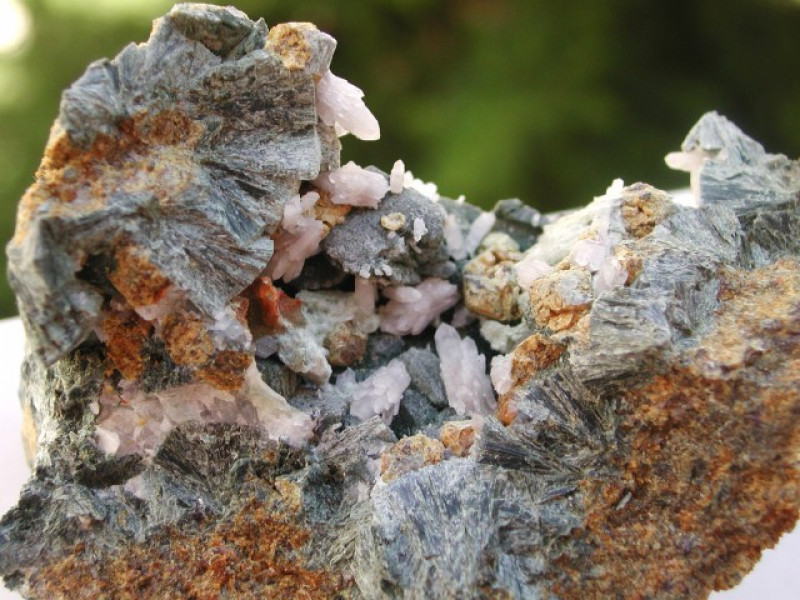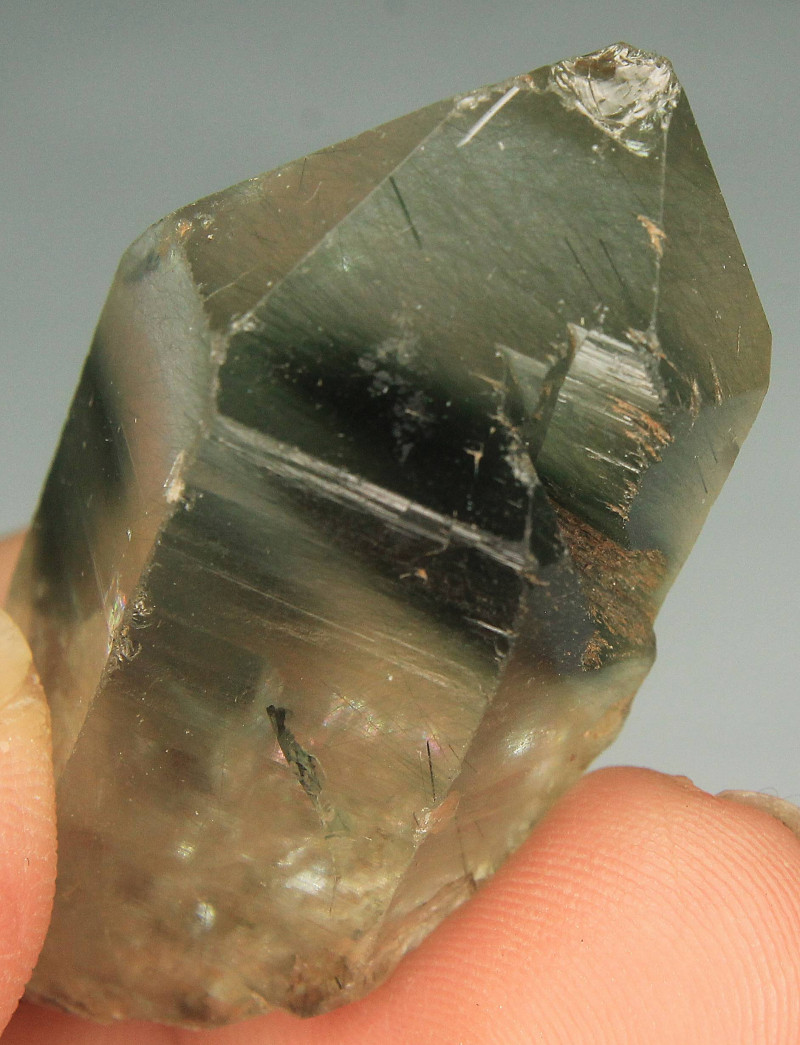
Actinolite Gemstone: Properties, Meaning, and Value Guide
 Actinolite is a generally translucent, green to black gemstone that sometimes displays a “cat’s eye” effect. This fibrous amphibole mineral is similar to tremolite and often forms glassy, flattened crystal prisms.
Actinolite is a generally translucent, green to black gemstone that sometimes displays a “cat’s eye” effect. This fibrous amphibole mineral is similar to tremolite and often forms glassy, flattened crystal prisms.
Is actinolite rare or common? Actinolite crystals are pretty common worldwide, though transparent, gem-quality stones are somewhat rare. It’s also not a well-known gem, so you won’t see it in mainstream jewelry shops.
Even if you’ve never heard of actinolite before, you probably know jade, right? Well, actinolite plays a major role in the composition of one of the two jade stones!
Want to learn more? Follow along as we uncover actinolite varieties, gemstone options, properties, and more!

About Actinolite Stone
Actinolite is a semi-precious gemstone often associated with the precious stone emerald for its similar lush green hues. In fact, high-quality, emerald-green actinolite masses are sometimes called “emerald spar.”
As such, actinolite can be an affordable alternative to emerald as a May birthstone. Additionally, actinolite is a star stone for Mars, plus a zodiac stone for Mars-ruled Aries and Scorpio.
What is actinolite used for? The mineral has a few industrial uses, like:
Paint
Cement
Gardening
Insulation & fire-proofing (like talc)
This mineral falls under the asbestos family, specifically the amphibole subgroup. Wait, asbestos? Is actinolite dangerous? In gemstone form, actinolite is safe, especially in its acicular (needle-like) habit, but we’ll discuss more about safety later on.
From a mineral standpoint, what is actinolite made of?
Actinolite Specifications & Characteristics
The actinolite mineral is an amphibole silicate containing calcium, magnesium, iron, silica, and hydroxide. It’s the middle member of a mineral series with tremolite and ferroactinolite.
Chemically, tremolite has more magnesium but ferroactinolite has more iron. Actinolite’s magnesium and iron content vary, but the iron content rarely exceeds 50 percent.
Tremolite and actinolite are often virtually indistinguishable. Sometimes iron replaces magnesium in tremolite, making it even closer to actinolite. Low-iron tremolites are gray or white.
You may see raw actinolite as long crystals or masses of compact fibers. Most actinolites look green naturally but light green or colorless under a microscope.
Mohs hardness: 5-6
Color: Light to dark green, grayish-green, greenish-black, black, or colorless
Crystal structure: Monoclinic
Luster: Vitreous (glass-like) or silky, sometimes dull
Transparency: Transparent to translucent, sometimes opaque
Refractive index: 1.61-1.64
Density: 2.95-3.30
Cleavage: Perfect or good on [110] with 2 directions (120° and 60° intersections)
Fracture: Uneven or splintery
Streak: White
Luminescence: None
Pleochroism: Present, yellow or yellow-green to green or brown
Optical effects: Chatoyancy

Types of Actinolite
There’s one official variety of actinolite, but other stones are sometimes considered varieties. We’ll also discuss stones often composed of (or included by) actinolite.
Smaragdite
Smaragdite is the only “official” actinolite variety. This stone is slightly heavier than actinolite, though its refractive index is lower. The name comes from the Ancient Greek smaragdus or Latin smaragdos, meaning “green” or “emerald,” after the coloring caused by chromium impurities.
Historically, “smaragdite” applied to numerous green-colored rocks and minerals. Some use the term for rocks containing long, green actinolite crystals found in the European Alps. Others use the term for zoisite, diopside, green quartz, or actinolite. Still others refer to glass emerald simulants as “smaragdite.”
Byssolite
Byssolite (or amiant) is a fibrous mass or needle-like crystal sometimes considered a variety of actinolite. This green to teal stone is usually composed of a hair-like mat of small, interwoven crystals of tremolite or actinolite.
Along with chrysotile, byssolite is behind the feathery “horsetail” inclusions in demantoid garnet that can increase the gem’s value.
Cat’s Eye Actinolite

Not an “official” variety per se, cat’s eye actinolite are rare actinolite gemstones that display chatoyancy, or the “cat’s eye” effect.
The fiber bundles in these translucent gems are parallel and aligned in a way that allows light to reflect in a thin, white beam across the stone’s surface.
Sometimes, sellers call this stone “cat’s eye jade.” But is actinolite a jade?
Nephrite Jade

Actinolite is not a jade variety, but it can be an essential part of nephrite, the more common but less valuable of the two jade stones (with jadeite). Many gemologists consider this gem a part of the actinolite mineral series, as nephrite is largely composed of dense, fibrous tufts of either actinolite or tremolite.
If actinolite (or ferroactinolite) is the main ingredient, nephrite displays actinolite-like dark shades of green. Many experts consider chatoyant “nephrite” to actually be a tremolite or actinolite cat’s eye, as nephrite’s fibers aren’t parallel.
When nephrite is composed of small, dense, and interwoven bunches of tremolite crystals, it’s usually paler, like the yellowish-white “mutton fat jade.” If tremolite crystals are just an inclusion, the nephrite can display white stripes dubbed “water lines.”
Speaking of inclusions…
Actinolite Quartz

You’ll more often see actinolite as an inclusion in other gems than as a gem itself. Actinolite in quartz is the most common, where it forms green to black acicular (needle- or blade-like) shapes. If actinolite, tremolite, rutile, and mica are present as inclusions in quartz, the stone is called “Witch’s Finger.”
On the topic of the mystical, what does actinolite mean?
Actinolite Meaning & History
Actinolite’s name comes from the Ancient Greek aktinos, meaning “beam” or “ray” after the stone’s radiated crystal habit and fibrous structure. Figuratively, aktinos also translates to “splendor” or “brilliance.” Likewise, actinolite symbolizes radiant light.
Some call actinolite the “Stone of Dreams” for the belief that it helps in dream interpretation and past-life exploration.
In Traditional Chinese Medicine, actinolite (Yang Gi Shi) treats problems related to the kidney, male impotence, and female infertility. Since ancient times, cat’s eye stones like cat’s eye actinolite were used as protection against the evil eye, an envious look believed to purposefully or inadvertently cause the receiver harm.
History
It’s unclear who discovered actinolite, but the eccentric Irish geologist Richard Kirwan reportedly gave actinolite its name in 1794.
“Actinolite” was actually a translation of Strahlstein, a German term for “jet stone” or “radiated stone,” depending on the translator. Interestingly, strahlstein also means “strong” or “masculine.”
While it’s not entirely clear if Kirwan was the first, the descriptions of actinolite (and other minerals) in his 1794 work Elements of Mineralogy were essential to establishing mineralogy as a legitimate science.
The “Father of Modern Crystallography,” French mineralogist René Just Haüy, chose the term “amphibole” in 1797 to describe the group of minerals. The name came from the Greek amphibolos, for “ambiguous,” after the variable properties and looks of its members (actinolite, tremolite, tourmaline, and hornblende at the time).

Actinolite Healing Properties
All varieties of actinolite can function as healing stones, with some carrying the properties of their coloring.
Green gemstones like green actinolite and nephrite are used as chakra stones for the heart chakra, along with changing negative energies to positive ones.
Meanwhile, black actinolite joins other black gems in its common uses for healing the root chakra and providing protection.
Physical Healing
Physical actinolite benefits touted by crystal healers include:
Detoxifying the body
Boosting metabolism
Strengthening the immune system
Like jade, actinolite is similarly said to treat the kidneys and encourage better physical balance.
Emotional Healing
Actinolite is said to bring you greater self-confidence, bravery, and emotional strength. Spiritual healers believe it can help those struggling with deep-rooted emotional wounds, allowing them to process the pain without being overcome by it.
Other purported emotional benefits include protection from negativity and harmful energies, either internally or externally, and reducing stress.
If you’re looking for spiritual value, actinolite has it. But what about actinolite’s value as a gemstone?

Actinolite Gemstone Properties
Not all actinolite types are used for gemstone purposes. The main gemstone varieties are nephrite, cat’s eye actinolite, and actinolite in quartz, though transparent actinolite crystals may be used as well.
The value of these gems comes from their color, cut, transparency, and clarity.
Color
The most common colors of actinolite are shades of green to black. Higher iron content produces darker greens in all actinolite stones, including nephrite. Some rare specimens are colorless and more valuable.
Cat’s eye actinolite can be colorless, white, yellow, brown, gray, or black. Usually, it’s yellow to green. Nephrite is most valuable in its rare white coloring.
Cut
Most actinolite crystals are difficult to cut, making faceted shapes rare and sought-after. They’re also always small, though actinolite rough from Vermont, USA, has lended 10-carat faceted gems.
Faceted nephrites are a recent phenomenon, as both jades aren’t traditionally faceted. Nephrites typically become carvings, beads, or cabochons. Large bangles are highly valuable.
Cat’s eye actinolite gems are cut as cabochons to properly display the optical effect. Smaragdite may be faceted or carved.
Transparency
The most valuable actinolite gems are transparent, faceted options. Similarly for quartz containing actinolite, more transparent quartz provides greater visibility of the actinolite needles, making it more valuable.
Cat’s eye actinolite may be translucent to opaque. Translucent options may be higher-valued, but a strong cat’s eye takes precedence.
Nephrite is rarely close to transparent, so these rare specimens are also sought-after.

Actinolite Formation & Sources
Actinolite forms through low-grade metamorphism, a rock alteration process that happens at relatively low temperatures (200-300℃) and low pressure. The type may be regional or contact metamorphism and usually occurs on calcium-magnesium carbonate rocks like dolostone.
In regional metamorphism, pressure and heat are equally influential on transforming the rock and its minerals. In contrast, heat does most of the transformative work in contact metamorphism.
Miners find most actinolite minerals in schists. One such rock is actinolite schist, a foliated stone characterized by being mostly composed of actinolite. Actinolite is also found in amphibolite, a metamorphic rock abundant in amphibole minerals like actinolite.
That said, where is actinolite mined?
Mining Locations
Actinolite is found worldwide. The most abundant current sources are:
Brazil
Canada (cat’s eye)
China
Madagascar (cat’s eye & dark green, facetable actinolite)
New Zealand
Russia
Taiwan (cat’s eye)
Tanzania (transparent actinolite & smaragdite)
Wales
The USA once had many actinolite amphibole mines but closed the last one in 2002.

Actinolite Price & Value
You may wonder: is actinolite worth anything? Yes, though some varieties are significantly more valuable than others.
Cat’s eye cabochons have a broad range of price points, from $10-$135 per carat, but most are $10-$20 per carat.
Quartz with actinolite for sale also varies in price. Tumbled stones can be as low as $4, whereas cabochons and faceted gems range from $30-$50 each. Raw crystals are the priciest, starting at $30 and reaching $1,500.
Faceted actinolite gemstones are the rarest and thus, highly valuable. These gems range from $50 to upwards of $450.
Actinolite Care and Maintenance
It’s important to care for gemstones, but it’s more important to care for your own health first. So, is actinolite crystal dangerous?
If polished in any form (faceted, cabochon, etc.), actinolite is safe to handle. We recommend staying away from rough, fibrous specimens without proper safety training.
Now, how do you clean actinolite? Actinolite is very stable to chemicals, so you can use muriatic acid for stains or dirt. Just follow that by rinsing it with water and soaking it in a rust-stain remover like Iron Out or a baking soda solution.
An easier cleaning method is wiping the stone down with a soft, non-abrasive cloth or using warm, soapy water (just remember to rinse away soap residue). For extra safety, you can wear gloves and a face mask while cleaning the stone.
Store actinolite away from other gems.

Activate Your Spirit with Actinolite!
Despite their obscure status, actinolite gemstone varieties are worth a second look. Wearing a cat’s eye actinolite bracelet or meditating with one can provide protection, spiritual connection, and confidence.
Search the Gemstone Encyclopedia
Related Auctions
Related Articles
Azotic treatment of Topaz and Quartz is a treatment that creates a layer of color over a gemstone. Learn more about this treatment and check out our stones fro sale.
8th May 2018
Quartz and Topaz are two of the most common minerals on the planet. They also look very similar. Let's look at some properties of them and compare Quartz and Topaz.
23rd Oct 2018
Gemstones and crystals are capable of absorbing and conveying energy, that’s why it’s important to cleanse, re-charge and program your stones so that they may achieve their best potential.
9th May 2018
Latest Articles
Catapleiite is a lesser-known mineral and rare gemstone often found as stunning tabular rosettes near other rare stones. Discover the history, prices, benefits, and properties of catapleiite!
28th Apr 2025
Yugawaralite is a rare colorless, white, or pinkish zeolite crystal named for its discovery in Yugawara, Japan. Here we uncover the multifaceted history, properties, prices, and uses of yugawaralite.
24th Mar 2025
Simpsonite is a lesser-known mineral known on the gem market for its durability, yellow-orange color, and rarity. Discover all the properties, uses, prices, and history of simpsonite.
3rd Mar 2025
Article Categories
How To's is where you will find helpful articles from gem Rock Auctions on how to cut gemstones, select gemstones and buy gemstones.
9 Articles




